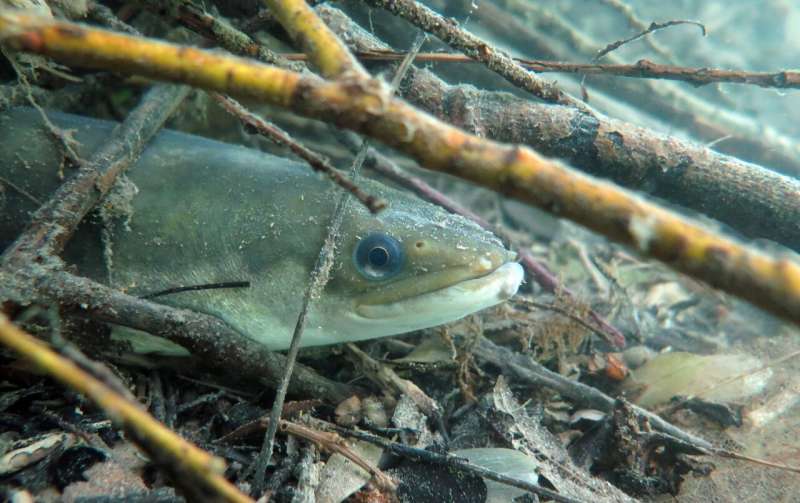Sensory evolution: Fish smelling well in the water and in the air

Some fish come onto the land to hunt or move around. Typically, this behavior happens at nighttime, as seen in eels, for instance. In the new study, researchers have found that such amphibious fishes might have an enhanced sense of smell. Their genomes revealed an unusually high number of the olfactory receptor genes that might facilitate smelling better in the air.
Additionally, these fish have also expanded the olfactory bulb within the brain. Analysis of two hundred fish species, including some that are able to move overland, suggests that the sense of smell in some amphibious fishes has adapted to their new way of life.
Zuzana Musilová, Demian Burguera and from the Fish Evolution research group and Pavel Němec, Francesco Dionigi, Kristina Kverková and Yicheng Zhang from the Sensory and Evolutionary Neurobiology group at the Faculty of Science of Charles University present a new study published in BMC Biology addressing this topic.
Zuzana Musilová and her team study the sensory systems of fishes. Mostly, they focus on vision, yet other essential sensory systems, such as smell, call their attention. The mechanism of olfaction is considerably less understood than of vision.
"For the sense of smell, we know the molecular basis of the olfactory receptors, which are basically proteins able to detect different substances. We can therefore focus on the genes coding these proteins and study their evolution," says Zuzana Musilová.
The further processing of odorants is also very interesting. Olfactory neurons transfer the signal from the receptors to precisely localized areas of the olfactory bulb, the area of the brain responsible for processing odorant information. This way, the sense of smell forms a kind of map in the brain.
Some mammals with a very good sense of smell, such as elephants for example, have thousands of olfactory receptor genes. Even humans, though not exactly olfactory specialists, present several hundreds of copies. However, previous studies involving a small number of fish species reported generally low numbers of receptor genes compared to many terrestrial animals.
"We were interested in fish, because they are a very varied group and in some types of genes, they show more diversity than other vertebrate groups," explains Zuzana Musilová. In the first step, Demian Burguera, the postdoctoral researcher in Zuzana's group, obtained genomic sequences from public databases and analyzed two hundred fish species.
And the genomic analysis revealed an exciting finding—the gene repertoire of smell receptors has been expanded in many amphibious fishes! This means fish that are capable of living out of water have more olfactory receptor genes.
"These so-called amphibious fishes come out of the water, mostly at night. On occasions, they are able to spend hours out of the water—either they hunt on land, or they explore and move to another location. European eels, for instance, are examples of such fish moving on land between water bodies," Demian Burguera describes. It turns out that the number of olfactory receptors reflects the biology of these fish, namely that they are able to use their sense of smell both under and above water.
The authors of the study found the same pattern in multiple fish lineages that have independently evolved their terrestrial exploration capacity. However, one group of fishes of extreme interest for this study was missing from their database: the airbreathing catfishes.
A previous study by other researchers recently demonstrated that a species from this lineage can orientate on land based on the detection of chemical signals. Therefore, the researchers further focused on a species from this group, the eel catfish, and analyzed it in detail for this study, finding an expansion in the number of olfactory genes compared to non-amphibious relatives.
Other studies have already shown that amphibians (frogs, salamanders, etc.) also have a large diversity of olfactory receptor genes, including subtypes that are common in fish and also subtypes that are common in terrestrial vertebrates. "Smell in the air and smell under wateusually means detecting different kinds of odorant molecules, so different receptors subtypes are usually used in those environments," says Zuzana Musilová.
"There are many types of odorant molecules that are only present in air or in water, due to their chemical and physical properties. However, a few particular odorants are known to be both soluble in water and volatile in air. We speculate that the function of many of those olfactory genes that increased their numbers in the genomes of terrestrial exploratory fishes could be to detect this last type of odorant molecules," says Demian Burguera, interpreting the results of the study.
Thus, the authors suggest that it was evolutionarily important for these lineages of fishes to develop a better sense of smell suitable for both environments.
The next part of the study involved a team of neurobiologists led by Pavel Němec, who examined the olfactory bulb of twenty-four fish species. This part of the brain is responsible for discerning olfactory information, and its relative number of cells (i.e., the cells of the olfactory bulb compared to the cells of the rest of the brain) reflects the processing capacity of the olfactory system.
The results show that the relative number of cells of the olfactory bulb differs in fishes according to this ecological feature—the sense of smell is more developed in nocturnal amphibious species than in other groups of fishes. Interestingly, the only species analyzed that still presents true lung structures for air-breathing and probably the oldest story of terrestrial exploration among fishes, the bichirs, present the most elaborate olfactory system of the whole dataset by far.
In summary, the olfactory system seems able to quickly respond to certain ecological challenges, such as the aerial environment in fishes, by multiplying and diversifying to meet new sensory needs. The authors of the paper further suggest that something similar might have occurred hundreds of millions of years ago during the water-to-land transition of our fish-like ancestors that later evolved in terrestrial vertebrates.
Thus, apart from more evident evolutionary processes such as the transformation of fins into limbs, a new type of sensory change might have been added to the list of those key evolutionary processes that allowed us—and many other animals—to live on land.
More information: Demian Burguera et al, Expanded olfactory system in ray-finned fishes capable of terrestrial exploration, BMC Biology (2023). DOI: 10.1186/s12915-023-01661-8
Journal information: BMC Biology
Provided by Charles University Study of olfactory bulb ratio in modern birds suggests dinosaurs may have had strong sense of smell






